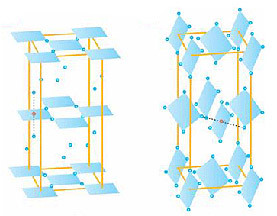
Models of two crystals: La2CuO4 (left) and Cs2AgF4.
A crystal is an organizational form of matter made of a building block called a unit cell. A unit cell can contain a few atoms, or it can contain many molecules. It's repeating this unit cell over and over again in space that makes a crystal. Everyday matter is composed of many, many tiny crystals that are usually randomly oriented. That is not very useful for our experiments because we want to look at how the properties of materials change when you apply certain magnetic fields in certain directions. So we want to make sure all those little crystals are lined up. The crystals that we make here are mostly magnetic crystals, or crystals that have unusual electrical properties, since we like to probe them in high magnetic fields or under different conditions. The way that we typically make crystals is through a device called an image furnace, and the image furnace grows crystals through light. So light can heat up matter to very high temperatures and we use that to melt our starting materials. If we cool that very slowly, we can wait for the atoms to arrange in perfect crystalline form. And that's what we use in a lot of our experiments.


